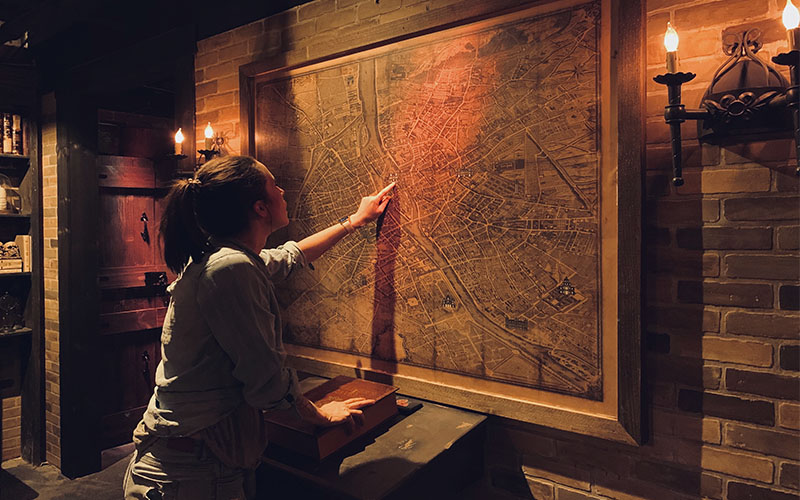Difficulty Your Mind With Our Intriguing Escape Room Puzzles and Clues
Getting started on a getaway room experience offers a complex experience that mixes cognitive obstacles with immersive storytelling. Each area, thoroughly crafted with unique styles, draws participants right into a world where reasoning, observation, and physical challenges converge.
The Art of Challenge Layout
The art of puzzle layout in escape spaces is a imaginative and precise procedure that requires a deep understanding of both cognitive and emotional involvement. Crafting a successful challenge entails balancing complexity with solvability, ensuring that participants stay tested yet not overwhelmed. This balance is critical, as it promotes a sense of success and promotes continued interaction.
Problem developers should think about numerous cognitive skills, such as pattern recognition, deductive reasoning, and spatial understanding. These components should be interwoven perfectly within the story of the retreat area, enhancing the immersive experience. Emotional interaction is just as important; challenges must stimulate inquisitiveness, excitement, and occasional disappointment, encouraging individuals to be determined and ultimately succeed.
Attention to detail is critical. Every hint, prop, and system should be thoroughly created and checked to make certain capability and comprehensibility within the story. Developers commonly repeat on their developments, integrating comments from test groups to refine trouble degrees and get rid of uncertainties.
Sorts Of Escape Room Difficulties
Understanding the details of problem style normally brings about an exploration of the diverse types of challenges experienced in getaway spaces. These difficulties can be extensively classified into physical challenges, logic challenges, and observational challenges, each offering special types of involvement and cognitive excitement.
Physical challenges need participants to engage with their atmosphere, typically including tasks such as putting together items, manipulating mechanisms, or revealing surprise areas. These difficulties engage tactile detects and spatial thinking, motivating team effort and hands-on problem-solving.
Logic problems, on the various other hand, demand analytical reasoning and pattern acknowledgment. Individuals may be charged with decoding ciphers, solving mathematical troubles, or finding connections between apparently unassociated clues - escape room in seattle. These challenges are developed to test the gamers' deductive reasoning and intellectual expertise
Observational puzzles depend on keen attention to information. Players have to scrutinize their environments to determine subtle tips, discrepancies, or concealed messages. These difficulties frequently demand a sharp eye and an ability to view connections that might forget.
Approaches for Success
Achieving success in escape areas requires a thoughtful blend of approach and partnership. Teamwork is extremely important; players have to leverage their cumulative strengths to fix complicated problems effectively. Separating tasks according to private skills can improve the procedure-- those with a knack for pattern acknowledgment can handle visual problems, while logical thinkers deal with sequences and puzzles.
Reliable communication is one more keystone of success. Sharing discoveries immediately ensures and avoids copied initiatives everyone stays on the exact same web page. Making use of a central area to put located things can help track development and prevent missing out on essential clues.
Time management is similarly vital. Allot a specific amount of time to each challenge, preventing extended concentrate on any kind of solitary obstacle. Seeking or switching puzzles assistance from teammates can provide fresh perspectives. if progression stalls.
It's additionally beneficial to acquaint oneself with typical retreat room styles and challenge kinds beforehand. Comprehending prospective puzzle formats, such as ciphers or lock mixes, can expedite analytical.
Finally, keeping a favorable and composed mindset under pressure can dramatically influence performance. Tension can cloud judgment, so keeping tranquil makes sure clear thinking and reliable cooperation, resulting in a higher chance of effectively leaving.

Advantages of Escape Rooms
Involving in retreat areas supplies a multitude of benefits that extend past mere entertainment. These link immersive experiences serve as a robust platform for developing crucial thinking and problem-solving skills. Individuals are called for to assess ideas, recognize patterns, and design remedies under time restraints, promoting imagination and cognitive versatility.
Furthermore, escape areas are an effective device for improving teamwork and communication. The joint nature of these tasks requires efficient communication and control amongst employee. This setting urges participants to articulate their ideas plainly, listen proactively, and job synergistically towards a common objective, consequently reinforcing social skills.
Moreover, escape areas supply an exceptional avenue for tension relief and psychological renewal. The engrossing nature of the challenges permits individuals to divert their emphasis from everyday stressors, advertising a sense of accomplishment and health upon resolving the puzzles. This can bring about enhanced psychological health and wellness and increased performance in other locations of life.
Finally, these experiences often call for creativity and resourcefulness, which can convert into cutting-edge analytical capacities in expert setups. By participating in retreat rooms, people can hone a varied ability set that applies in different real-world circumstances, making them an important enhancement to any professional or individual growth plan.
Popular Themes and Situations
Diving into the varied globe of getaway areas reveals a myriad of prominent motifs YOURURL.com and scenarios that mesmerize individuals and heighten the immersive experience. Among the most precious motifs are those that transfer players right into historic durations or fantastical realms. As an example, ancient Egyptian burial places, middle ages castles, and pirate journeys are perennial favorites, enabling participants to fix problems within highly detailed settings that evoke a sense of experience and exploration - best escape room.
One more prevalent theme is the mystery and detective genre, where players find themselves in the role of sleuths solving a crime or uncovering secrets. These circumstances often feature intricate stories and a collection of interconnected hints that need keen observation and deductive thinking to unwind.
Furthermore, sci-fi and horror themes hold substantial appeal, drawing on the intrigue of advanced innovation or the excitement of navigating haunted research laboratories and homes. These scenarios frequently include unique effects and advanced props, boosting the realism and stress.
Last but not least, numerous escape areas attract inspiration from preferred society, creating experiences based on cherished books, flicks, or television shows. This can create a sense of knowledge and enjoyment, as participants involve with scenarios that admire their preferred stories.
Final Thought
The intricate layout of escape area puzzles and ideas provides an unique blend of cognitive obstacles and immersive storytelling. By taking part in different kinds of physical, rational, and empirical puzzles, individuals refine essential thinking and synergy skills. Using effective methods enhances the overall experience, highlighting the complex advantages of getaway areas. Popular situations and themes additionally improve the adventure, making getaway areas a compelling and academic activity for improving psychological acuity and analytical capacities.
Each area, meticulously crafted with distinct styles, draws participants into a world where logic, monitoring, and physical challenges assemble.The art of problem layout in retreat areas is a creative and meticulous process that requires a deep understanding of both cognitive and emotional engagement. Crafting an effective problem entails stabilizing complexity with solvability, ensuring that individuals continue to be tested yet not bewildered. The gripping nature of the difficulties enables individuals to look at this web-site divert their focus from daily stress factors, advertising a feeling of achievement and wellness upon resolving the puzzles.The intricate layout of retreat space challenges and clues offers an unique mix of cognitive difficulties and immersive storytelling.
 Devin Ratray Then & Now!
Devin Ratray Then & Now! Michael J. Fox Then & Now!
Michael J. Fox Then & Now! Karyn Parsons Then & Now!
Karyn Parsons Then & Now! Shannon Elizabeth Then & Now!
Shannon Elizabeth Then & Now! Susan Dey Then & Now!
Susan Dey Then & Now!